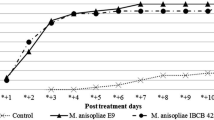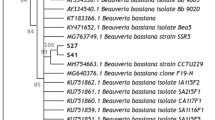Abstract
The objective of this work were to isolate and identify strains of entomopathogenic fungi from ingurgitated female Boophilus microplus ticks, collected from the soil in the municipality of Paracambi, Rio de Janeiro State, Brazil. The ingurgitated females were inoculated in the selective medium oat dodine agar (oda), where 49 colonies of Beauveria bassiana (71%) and 20 of Metarhizium anisopliae var. anisopliae (29%) were isolated. These isolated strains characterize for the first time in Brazil the natural occurrence of these species of fungi in this tick, and will be used to conduct bioassays to evaluate the pathogenicity and virulence of these strains for ticks of the genus Boophilus microplus.
Similar content being viewed by others
References
Alves SB. Controle Microbiano de Insetos. Piracicaba. Fealq. 1998.
Aragão H, Fonseca F. Notas de Ixodologia. VIII Lista e chave para os representantes da fauna ixodológica brasileira. Mem Inst Oswaldo Cruz 1961; 59(2): 115–130.
Burges HD, Hussey NW, eds. Microbial control of insects and mites. London: Academic Press, 1971; 357–374.
Chase AR, Osborne LS, Ferguson VM. Selective isolation of the entomopathogenic fungi, Beauveria bassiana and Metarhizium anisopliae from an artificial potting medium. Flo Entol 1986; 69: 285–292.
Cherepanova NP. Fungi which are found on ticks. Bot ZMosk 1964; 49: 696–699.
De Hoog GS. The genera Beauveria, Isaria, Tritirachium and Acrodontium gen. nov. Studies in Mycology 1972; 1: 1–41.
Hawksworth DL. Mycologist's handbook. Engalnd: CAB Press, 1971.
Hernández-Crespo P, Santiago-Álvarez C. Entomopathogenic fungi associated with natural populations of the Moroccan Locust Dociostaurus maroccanus (Thunberg) (Orthoptera: Gomphocerinae) and other Acridoidea in Spain. Biocontrol Science and Technology 1997; 7: 357–363.
Kalsbeek V, Frandsen F, Steenberg T. Entomopathogenic fungi associated with Ixodes ricinus ticks. Experimental & Applied Acarology 1995; 9: 45–51.
Lipa JJ. Microbial control of mites and ticks. In: Buerges HD, Hussey NW, eds. Microbial control of insects and mites. London: Academic Press, 1971: 357–374
Mwangi EN, Kaaya GP, Essuman S. Experimental infections of the tick Rhipicephalus appendiculatus with entomopathogenic fungi, Beauveria bassiana and Metarhizium anisopliae and natural infections of some tick with bacteria and fungi. J Afr Zool 1995; 109: 151–160.
Penna VM. Boophilus microplus. A resistência genética do hospedeiro como forma de controle. Cad Tec Esc Vet UFMG 1990; 4: 3–65.
Poprawiski TJ, Yule WN. Incidence of fungi in natural populations of Phyllophaga spp and susceptibility of Phyllophaga anxia (Le Conte) (COL. Scarabalidae) to Beauveria bassiana and Metarhizium anisopliae (Deuteromycotina). J Appl Ent 1991; 112: 359–365.
Rivalier E, Seydel S. Nouveau procedé de culture sur lames gélosés appliqué a l étude microscopique des champignos deteignes. Ann Parasitol 1932; 10: 444–452.
Roberts DW, Campbell AS. Stability of entomopathogenic fungi. Misc Publ Entomol Soc Am 1977; 10: 19–76.
Roddam LF, Rath AC. Isolation and characterization of Metarhizium anisopliae and Beauveria bassiana from Subantartic Macquarie Island. J Invertebr Pathol 1997; 69: 285–288.
Rombach MC, Humber RA, Roberts DW. Metarhizium flavoviride var. nov. a pathogen of plant and leafhoppers on rice in the Philippines and Salomon Island. Mycotaxon 1986; 27: 87–92
Rombach MC, Humber RA, Evans HC. Metarhizium album a fungal pathogen of leaf and planthoppers of rice. Trans Br Mycol Soc 1987; 87: 1–9.
Samsinakova A. Beauveria globulifera (Speg) Pic Jako Parasit Klistete Ixodes ricinus. L Zoologie List 1956; 6: 329–330.
Samson RA. Constrains associated with taxonomy of biocontrol fungi. Can J Bot 1995; 73: 83–88.
Seymour R, Cowgill MM, Klecka GM, Gersich FM, Mayes MA. Occurrence of Aphanomyces daphniae infection in laboratory cultures of Daphnia magna. J Invertebr Pathol 1984; 43: 109–113.
Tarasco E, Bievre C de, Papierok B, Poliseno M, Triggiani O. Occurrence of entomopathogenic fungi in soils in Southern Italy. Entomologica, Bari 1997; 31: 157–166.
Tigano-Milani MS, Faria MR de, Martins I, Lecouona RE. Ocorrência natural de Beauveria bassiana (Bals) Vuill, Metarhizium anisopliae (Metsch) Sorok. e Paecilomyces sp em solos de diferentes regiões do Brasil. An Soc Entomol Brasil 1993; 22: 391–393.
Verissimo CJ. Inimigos naturais do carrapato parasita dos bovinos. Agrop Catarinense 1995; 8: 35–37.
Zimmerman G. The entomopathogenic fungus Metarhizium anisopliae and its potential as a biological agent. Pesticide Science 1993; 37:375–379.
Author information
Authors and Affiliations
Rights and permissions
About this article
Cite this article
da Costa, G., Sarquis, M., de Moraes, A. et al. Isolation of Beauveria bassiana and Metarhizium anisopliae var. anisopliae from Boophilus microplus tick (Canestrini, 1887), in Rio de Janeiro State, Brazil. Mycopathologia 154, 207–209 (2002). https://doi.org/10.1023/A:1016388618842
Issue Date:
DOI: https://doi.org/10.1023/A:1016388618842




